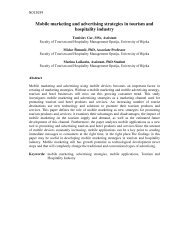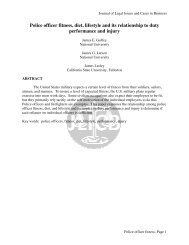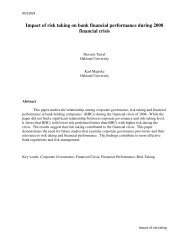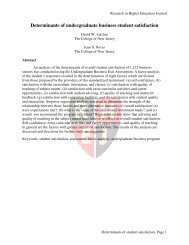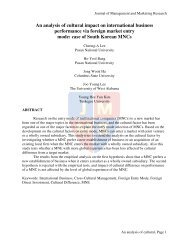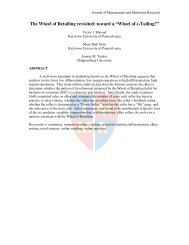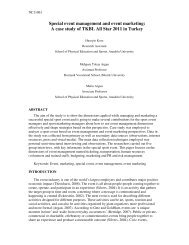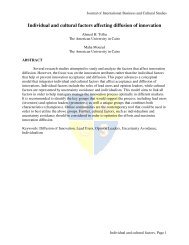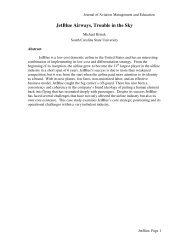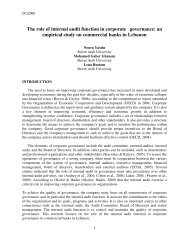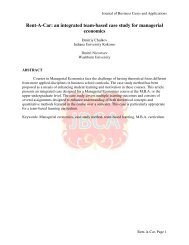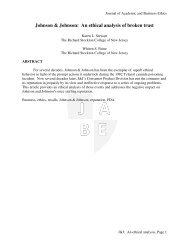Need-Based Segmentation Analysis of University Career Services ...
Need-Based Segmentation Analysis of University Career Services ...
Need-Based Segmentation Analysis of University Career Services ...
Create successful ePaper yourself
Turn your PDF publications into a flip-book with our unique Google optimized e-Paper software.
Research In Higher Education Journal<br />
must make difficult choices. Finally, MDS provides ratio data and eliminates scale use bias<br />
(Cohen & Orme, 2004).<br />
Maximum Difference Scaling and <strong>Career</strong> <strong>Services</strong>: Designing the Study<br />
To identify the appropriate attributes for this study, the researchers conducted a literature<br />
review and a qualitative research study. Focus groups were conducted with the target population<br />
to explore relevant attributes to students, which was used to guide survey development.<br />
Focus groups were conducted with career service students to learn the following:<br />
� An in-depth understanding <strong>of</strong> the student experience, in general<br />
� Ways in which they use career service<br />
� Primary reasons for using career service<br />
� Primary reasons for NOT using various career services<br />
To recruit focus group participants, a list <strong>of</strong> students who had use career service was<br />
developed. The students were invited to participate via email. As an incentive, pizza and pop<br />
were provided to students attending the focus group. A total <strong>of</strong> eight students participated in one<br />
focus group. The student sample contained an even number <strong>of</strong> males and females with a variety<br />
<strong>of</strong> different backgrounds and perspectives.<br />
One <strong>of</strong> the researchers moderated the focus group, using an interview guide to help<br />
manage the group, yet the discussions were loosely structured and free flowing. The focus group<br />
began with general background and context style questions. Then, the students were asked<br />
questions concerning the reasons they chose to volunteer and how they got started volunteering.<br />
Probing questions were used to clarify responses and to examine the participant’s perspective in<br />
more detail. (i.e., “Tell me more about that?” or “What exactly do you mean by that?”). The<br />
focus group lasted for 1.5 hours.<br />
The focus group was videotaped, which helped facilitate data analysis. The researchers<br />
watched the focus group a number <strong>of</strong> times, taking detailed notes and using grounded theory<br />
analysis concepts. <strong>Based</strong> on the focus group results, the following key attributes were identified<br />
and used to build the attributes into MDS.<br />
<strong>Based</strong> on the literature review, focus group results, and discussions with <strong>Career</strong> Service<br />
personnel, final attributes were formulated. The MDS web-based survey instrument was then<br />
developed and tested on a convenience sample <strong>of</strong> undergraduate students. The convenience<br />
sample was used to make modifications to the survey. The final survey was posted on a secure,<br />
password protected web site.<br />
A large public Midwestern university supplied the researchers with a database <strong>of</strong> over<br />
9,000 undergraduate students registered with career services. Registered students with career<br />
services were used as the sampling frame because the purpose <strong>of</strong> this study is to examine how to<br />
get students to actually use career services once they were registered. Consistent with findings<br />
from the literature, the UCSC at this university was effective at getting students to register but<br />
not effective in getting students to actually use their services. From this database, 1000 students<br />
were randomly selected to be in the sample. Each student in the sample was invited, by email, to<br />
take the survey and 244 responses were collected, for a response rate <strong>of</strong> 24.4%. While<br />
researchers always want higher response rates, the research team was satisfied with the response<br />
rate. Given the current pressures and continued pressures on survey respondents, the response<br />
rate seems reasonable (Garver, Divine, and Spralls 2009).<br />
<strong>Need</strong>s-<strong>Based</strong> <strong>Segmentation</strong> <strong>Analysis</strong>, Page 7



